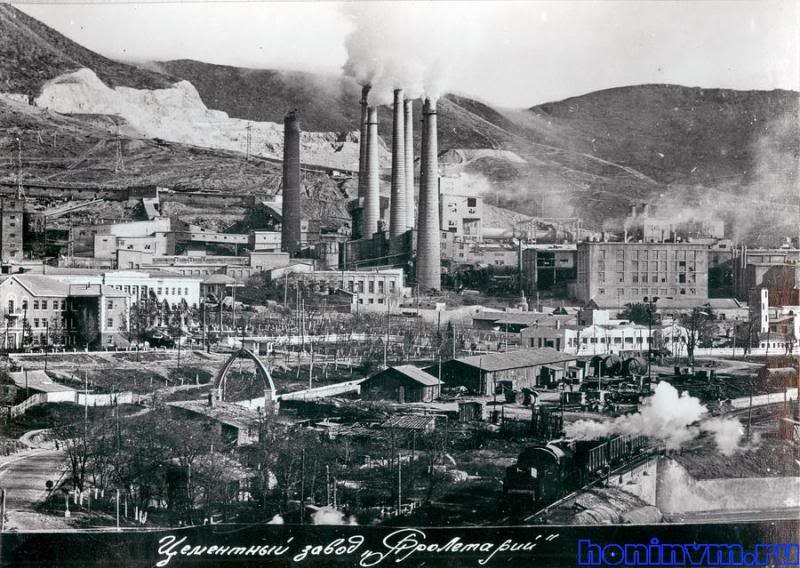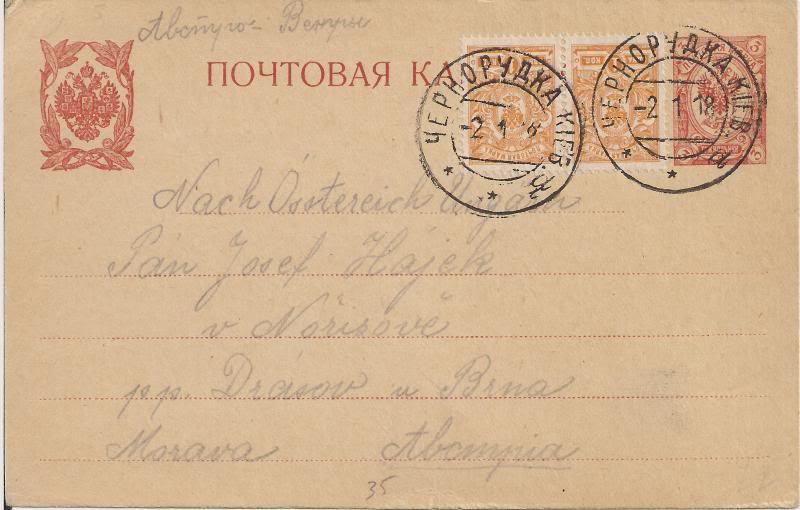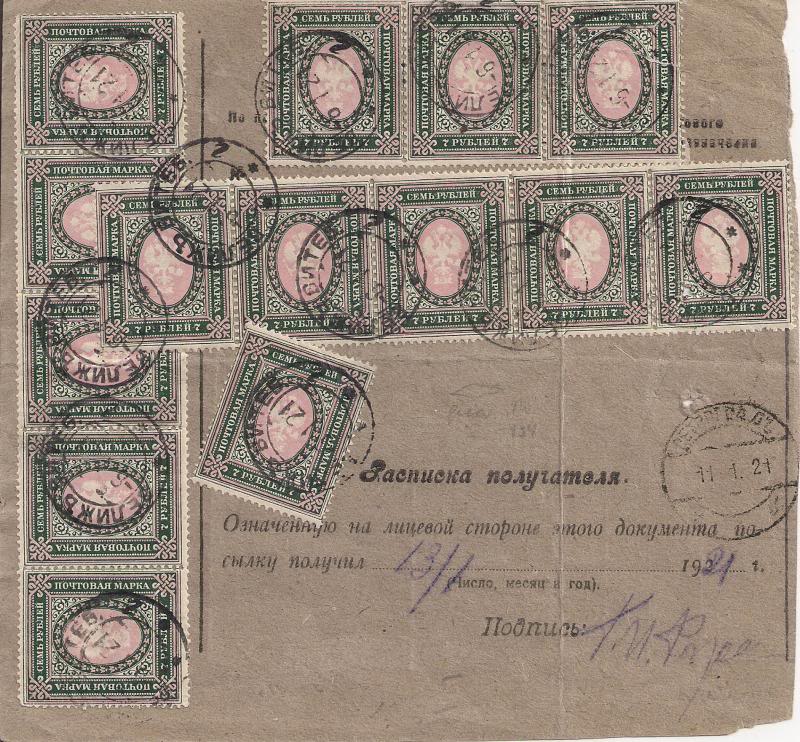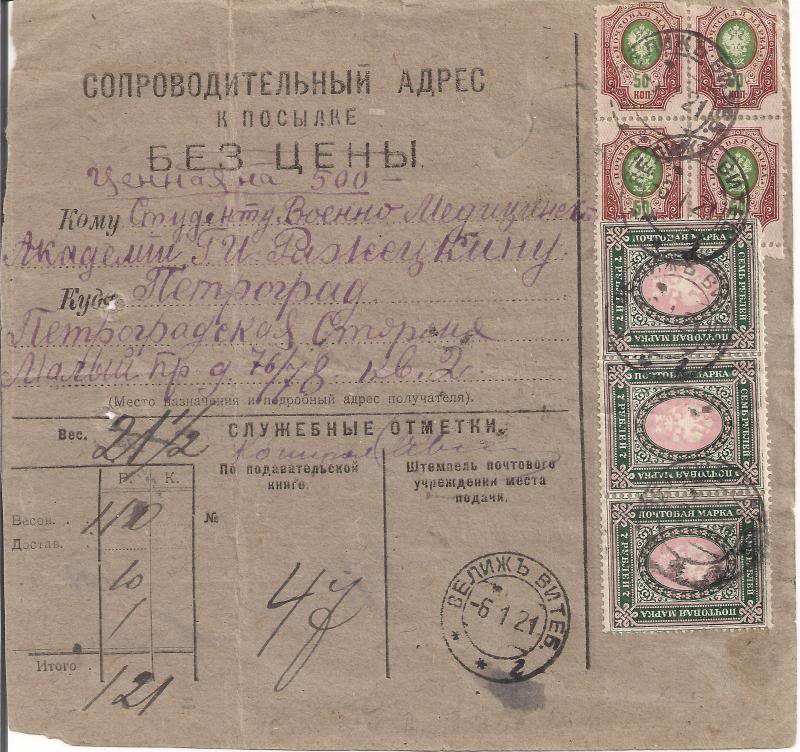Post by Admin on Mar 14, 2015 20:15:34 GMT
Here are some of the threads that have been posted the postmark calendar thread thestampforum.boards.net/thread/426/postmark-calendar.
This is just a taste if you wish to read more you will need to follow the link. These are all posts that vasia has posted in the postmark thread. This thread is a great read lots of hidden gems, any student of Rusian postal history will find this thread of great interst. Vasia has done some wonderful research on the subject.
December 31, 1925


Folded letter from Mykhailo-Lokrobskaya to Moscow, addressed to the All-Union Trade Union Headquarters. The letter was unfranked, it was received in Moscow on 2/1/1926, where it was stamped with a rectangular “Pry vydache...” handstamp (indicating that a charge should be collected, according to the postage-due stamp). Manuscript blue-crayon “7” on front. Postage-due is collected by the use of a postage-due stamp (typographed, perf 12), obliterated at the “temporary” post office located on the grounds of the Trade Union Hqs. Interestingly (and conceivably because this is considered semi-official mail, exempt from registration charges) the due is not assessed at deficit (7k) + registration (7k), but simply at deficit. This is the last month of use of postage due stamps - such stamps were used in the Soviet Union only for roughly 2 years, i.e during 1924-1925.
January 1, 1931

Postal stationery envelope from Tsementniy Zavod "Proletariy" (the "Proletarian" cement factory ) in Novorossiysk, Chernomorskaya (in the Black Sea) to Frankfurt (8/1) and re-directed to Eschborn on the same day, with receiving cancels from both. Franked correctly at 35k. The registration label is of the standard “R” type in black from Novorossisk, supplemented by hand to indicate dispatch from “cim zawod”. See below a photo of the cement factory. Addressed to the G. Schiele engineering works and iron foundry company (producing fans and blowers for mining and foundries).

January 2, 1918


A 3 kopeck Imperial postal card mailed from Chernorudka, Kiev to Brno in Moravia, Czechoslovakia (then Austro-Hungary). Franked at the pre-revolutionary domestic 5k rate with the addition of 2x1k perf Arms (the international rate was 8k). No postage-due assessed. It is highly possible that the card was written by a Czech POW (notice the language). The sender dates the card according to the Gregorian calendar, i.e 13 days ahead of the then applicable in Russia Julian calendar
This was a turbulent period for the Ukraine. In late November the Central Rada in Kiev had proclaimed an autonomous Ukrainian People's Republic (UPR) that did not recognize the Soviet government in Petrograd. Two weeks after the posting of this card, the UPR would introduce its own postal rates. These Ukrainian rates were soon replaced by the Soviet rates when the Red forces captured almost the entire Ukraine (including Kiev on February 8, 1918), but were re-introduced in late April when Ukrainian nationalists regained control of Ukraine on the heels of the invading German army.
January 3, 1924


A Notification-of-Receipt card posted in Moscow and addressed to Ekaterinograd, Samara province. The monetary equivalent of $20 is paid out on 11/1 and the card is returned registered on 14/1, reaching Moscow on the 19th. Franked at the appropriate N.o.R rate of 12k (i.e registered letter rate) with a vertical gutter pair. The provisional label is a blue-border insured-letter one of Ekaterinograd-on-Volga, presumably due to the lack of regular registration labels.
Ekaterinograd is in the Volga German area – on the back there is a manuscript reference to “Marxstaadt", its new name, as well as the inscription “Obl.Nem.Pov.” (=Volga German oblast, i.e prior to its elevation into an Autonomous Soviet Socialist Republic - ASSR in December 1924). Four years into the renaming of the city, the old imperial-period postmarks are still in use.
These cards were used to notify individuals of the receipt of a monetary sum from abroad. The recipient in Russia received (from the local bank branch) the monetary equivalent in rubles, signed the card and retained a stub attached to the left side of the card. The main part of the card was then returned to the central bank offices in Moscow and then shipped in batches to the corresponding foreign bank as proof that the money had been transferred.
During Soviet times they can be found in use from April 1922 until late 1929. They were franked at a concessionary rate of one-way letter rate or one-way registered letter rate (if registration was required). The franking and payment were done at the time of the original dispatch of these cards from the central bank offices, but the receiving post-office applied the necessary postmarks and registration labels prior to returning the card.
January 6, 1921


Parcel card from Velizh, Vitebsk to Petrograd (11/1/1921). The "no-declared value" card (as indicated in the third line of text) is modified by hand to reflect a declared value of 500 rubles. The weight of the parcel is calculated at 21.5 funts (1 funt = 410gr) and the charge levied for it is 111R + an insurance charge of 10R (apparently 2% of declared value). The card is franked with 17x7R (1919 Soviet re-issue) + 4x50k "Imperial" Arms (all serving at face value), for the correct total charge of 121R.
January 11, 1917


POW postal card from Tsaritsyn, Saratov (later Stalingrad) to Pardubice, Bohemia (then Austria-Hungary). Circular red-violet double ring handstamp (ПЕЧАТЬ ДЛЯ ПАКЕТОВЬ – stamp official mail, hence the free-frank). Black rectangular censor mark of Tsaritsyn. Partly overlapping it at bottom, a black handstamp with 3 large letters – probably Simbirsk censor initials. Red triangular Austrian censor from Vienna. Censored thus at least 3 times!
Two blue 2-line inscription handstamps (in Russian and French, applied in Russia and indicating POW correspondence). Message of card written in Czech language.
This is just a taste if you wish to read more you will need to follow the link. These are all posts that vasia has posted in the postmark thread. This thread is a great read lots of hidden gems, any student of Rusian postal history will find this thread of great interst. Vasia has done some wonderful research on the subject.
December 31, 1925


Folded letter from Mykhailo-Lokrobskaya to Moscow, addressed to the All-Union Trade Union Headquarters. The letter was unfranked, it was received in Moscow on 2/1/1926, where it was stamped with a rectangular “Pry vydache...” handstamp (indicating that a charge should be collected, according to the postage-due stamp). Manuscript blue-crayon “7” on front. Postage-due is collected by the use of a postage-due stamp (typographed, perf 12), obliterated at the “temporary” post office located on the grounds of the Trade Union Hqs. Interestingly (and conceivably because this is considered semi-official mail, exempt from registration charges) the due is not assessed at deficit (7k) + registration (7k), but simply at deficit. This is the last month of use of postage due stamps - such stamps were used in the Soviet Union only for roughly 2 years, i.e during 1924-1925.
January 1, 1931

Postal stationery envelope from Tsementniy Zavod "Proletariy" (the "Proletarian" cement factory ) in Novorossiysk, Chernomorskaya (in the Black Sea) to Frankfurt (8/1) and re-directed to Eschborn on the same day, with receiving cancels from both. Franked correctly at 35k. The registration label is of the standard “R” type in black from Novorossisk, supplemented by hand to indicate dispatch from “cim zawod”. See below a photo of the cement factory. Addressed to the G. Schiele engineering works and iron foundry company (producing fans and blowers for mining and foundries).

January 2, 1918


A 3 kopeck Imperial postal card mailed from Chernorudka, Kiev to Brno in Moravia, Czechoslovakia (then Austro-Hungary). Franked at the pre-revolutionary domestic 5k rate with the addition of 2x1k perf Arms (the international rate was 8k). No postage-due assessed. It is highly possible that the card was written by a Czech POW (notice the language). The sender dates the card according to the Gregorian calendar, i.e 13 days ahead of the then applicable in Russia Julian calendar
This was a turbulent period for the Ukraine. In late November the Central Rada in Kiev had proclaimed an autonomous Ukrainian People's Republic (UPR) that did not recognize the Soviet government in Petrograd. Two weeks after the posting of this card, the UPR would introduce its own postal rates. These Ukrainian rates were soon replaced by the Soviet rates when the Red forces captured almost the entire Ukraine (including Kiev on February 8, 1918), but were re-introduced in late April when Ukrainian nationalists regained control of Ukraine on the heels of the invading German army.
January 3, 1924


A Notification-of-Receipt card posted in Moscow and addressed to Ekaterinograd, Samara province. The monetary equivalent of $20 is paid out on 11/1 and the card is returned registered on 14/1, reaching Moscow on the 19th. Franked at the appropriate N.o.R rate of 12k (i.e registered letter rate) with a vertical gutter pair. The provisional label is a blue-border insured-letter one of Ekaterinograd-on-Volga, presumably due to the lack of regular registration labels.
Ekaterinograd is in the Volga German area – on the back there is a manuscript reference to “Marxstaadt", its new name, as well as the inscription “Obl.Nem.Pov.” (=Volga German oblast, i.e prior to its elevation into an Autonomous Soviet Socialist Republic - ASSR in December 1924). Four years into the renaming of the city, the old imperial-period postmarks are still in use.
These cards were used to notify individuals of the receipt of a monetary sum from abroad. The recipient in Russia received (from the local bank branch) the monetary equivalent in rubles, signed the card and retained a stub attached to the left side of the card. The main part of the card was then returned to the central bank offices in Moscow and then shipped in batches to the corresponding foreign bank as proof that the money had been transferred.
During Soviet times they can be found in use from April 1922 until late 1929. They were franked at a concessionary rate of one-way letter rate or one-way registered letter rate (if registration was required). The franking and payment were done at the time of the original dispatch of these cards from the central bank offices, but the receiving post-office applied the necessary postmarks and registration labels prior to returning the card.
January 6, 1921


Parcel card from Velizh, Vitebsk to Petrograd (11/1/1921). The "no-declared value" card (as indicated in the third line of text) is modified by hand to reflect a declared value of 500 rubles. The weight of the parcel is calculated at 21.5 funts (1 funt = 410gr) and the charge levied for it is 111R + an insurance charge of 10R (apparently 2% of declared value). The card is franked with 17x7R (1919 Soviet re-issue) + 4x50k "Imperial" Arms (all serving at face value), for the correct total charge of 121R.
January 11, 1917


POW postal card from Tsaritsyn, Saratov (later Stalingrad) to Pardubice, Bohemia (then Austria-Hungary). Circular red-violet double ring handstamp (ПЕЧАТЬ ДЛЯ ПАКЕТОВЬ – stamp official mail, hence the free-frank). Black rectangular censor mark of Tsaritsyn. Partly overlapping it at bottom, a black handstamp with 3 large letters – probably Simbirsk censor initials. Red triangular Austrian censor from Vienna. Censored thus at least 3 times!
Two blue 2-line inscription handstamps (in Russian and French, applied in Russia and indicating POW correspondence). Message of card written in Czech language.



